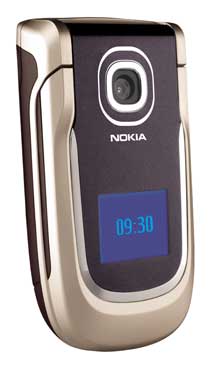Taking my iPhone to a music festival didn’t really seem like the most sensible idea: a capacitive touchscreen in a potentially muddy field? A battery that only just lasts a day? It’s not exactly suited to the wilderness, not to mention a little fragile.
At the same time: it’s exactly the place that connectivity comes in handy, for finding lost friends. And so I decided to take a spare. Unfortunately, all my old phones are locked to the wrong network, so it was time to make a trip to a phone shop and buy a cheap pay-as-you-go phone.

I ended up with the Nokia 2760, otherwise known as the “second cheapest Nokia in the shop”, which seemed like a safe bet. The clamshell form factor was another layer of protection from the elements (when I wasn’t sure what the weather would be like), and perhaps more importantly, meant that the keypad buttons were much larger than on equivalent candybar-shaped devices. That was a distinct advantage given the potential for drunk, clumsy texting when in the vicinity of the Somerset Cider bus.
I spent a weekend away from pervasive connectivity, from GPS, from Twitteriffic, from thousands of apps, and instead just took the state-of-the-art when it comes to really cheap, no-frills phones.
And, you know, it was absolutely fine. The phone does everything you’d expect it to: it makes calls, it sends texts, it has a simple camera, and it has an alarm clock. I still have the muscle memory for Nokia’s T9 implementation. I could have installed Opera Mini on it (far better than the built-in browser) primarily for using Twitter, but really, I wouldn’t mess with it in any other way. And, of course, the hardware is great, as you’d expect from a firm with the industrial design experience of Nokia: it’s pleasant to hold in the hand, and it certainly doesn’t feel cheap. Also, it’s small; smartphones really have made me forget how tiny phones had got at one point, and the 2760 is a reminder that much smaller packages still exist.
Using the Nokia over the long weekend also reminded me that my usage of mobile phones has actually changed very little in the past decade. When it comes to the functionality of a phone, there’s almost no difference between my iPhone and the Nokia: they call, they make texts, they have a few useful features. Most of the change in my use comes down to the “smart” half of the smartphone: all the features that have converged from other devices. I no longer carry an iPod around with me; I no longer need an A to Z on me; I write my to-do lists into Things rather than my notebook; I can get on the web without complicated Bluetooth rituals.

But none of it is necessarily unique – or vital – to my experience of the phone-as-mobile-communicator. I enjoyed the practicality and immediacy of the Nokia. I often find the wall of phones you see in shops tiring now – a series of black slabs, all identical in appearance thanks to the ubiquitous touchscreen, all to be distinguished by the software they run (which is usually never demonstrated in shops). The 2760 wears its phone-ness on its sleeve.
The magic of mobile phones is, first and foremost, that they are wireless communicators. You can talk, to other people, anywhere in the world, without wires. Everything else – all the magic in your convergence device – is something else. What phones have become, but perhaps they’ve transcended that description of phone-ness. All that is nice to have, for sure, and I’m very glad to have my iPhone back, but I was not once inconvenienced.
And here’s the big takeaway for me: it was fascinating to realise just how good the low-end products on the mass market today are. It’s easy to talk excitedly about innovation, and the new possibilities brought by every-more-advanced technology. It’s not much harder to be excited by products for emerging and developing markets, finding ingenious ways to bring costs right down and, potentially, change lives that have never experienced new kinds of technology. But it’s a lot harder to be excited the territory that lies between those two: refinement for the mass market of the developed world; products so unashamedly not new, but instead a continuation of past innovation, often doing nothing more than bringing that technology to a wider market at a lower price.
That’s as much part of design as new and shiny, and we don’t talk about it enough. The design community talks a lot about products like the iPod, but never the $20 MP3 players you find in the Sears catalogues. We talk about Chumbys and Pleos, but never the hundreds of items on shelves in Toys R Us right now, that are selling, and played with, and distill (sometimes well, sometimes terribly) so many of the ideas we, as a design community, talk about, into a $30 toy.
We shouldn’t stop talking about the iPods and the Roombas, either, but it’s worth remembering there is a world outside the five or six ubiquitous examples that do the rounds in conference season. And that’s what I learned when I bought a cheap mobile phone to take to a field.